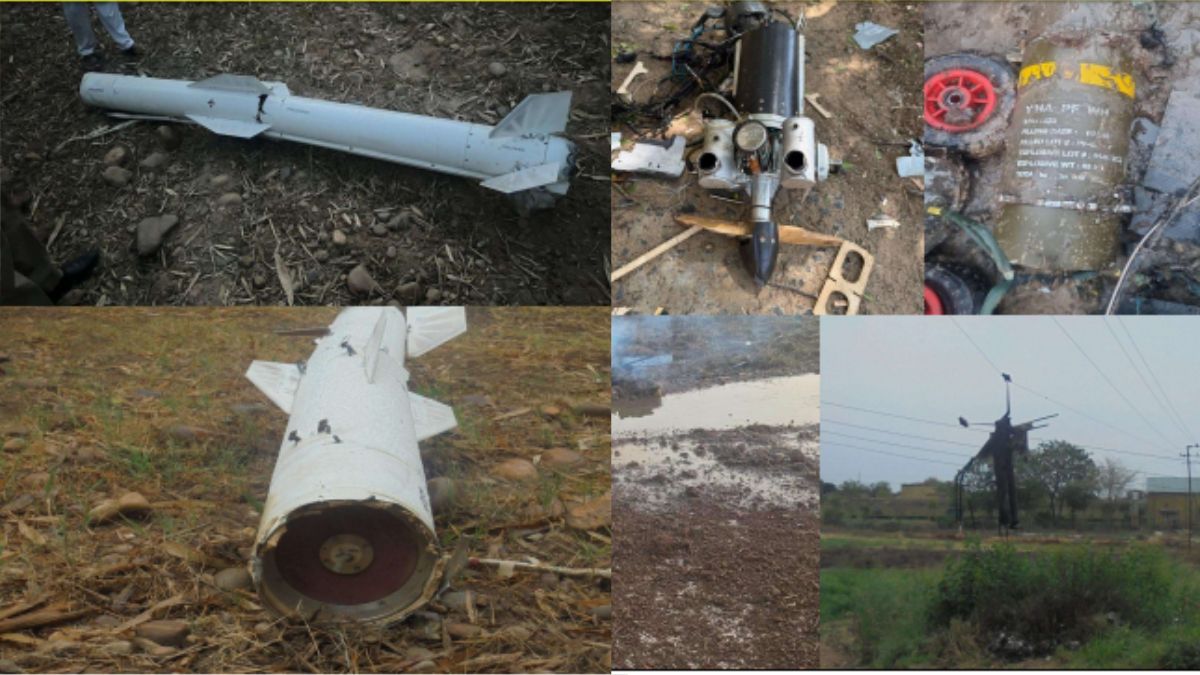India’s Armed Forces recently intercepted and neutralised a range of high-tech foreign weaponry used by Pakistan, including Chinese-origin PL-15 air-to-air missiles and Turkish Byker YIHA III kamikaze drones.
During a press briefing on Monday (May 12, 2025), DG Air Operations Air Marshal AK Bharti presented visual evidence of the missile remnants during a joint military press briefing. “You can see the pieces of it on the screen,” he said, showcasing debris of the PL-15 that fell inside Indian territory, including a relatively intact rear section recovered from Hoshiarpur, Punjab.
Operation Sindoor, which drew in coordinated responses from the Indian Army, Navy and Air Force, was discussed at the joint tri-services briefing in New Delhi .
At the forefront of Pakistan’s recent aerial aggression were the PL-15 air-to-air missiles, which were deployed by Pakistan’s Air Force but failed to hit their intended targets.
In addition to the missiles, the Indian military also recovered wreckage of Turkish-origin Byker YIHA III drones and Songar loitering munitions , which were launched by Pakistan in the early hours of May 10.
These drones, carrying high-explosive payloads, were reportedly aimed at civilian zones in Amritsar, Punjab, according to official sources.
They were intercepted and destroyed by India’s Army Air Defence (AAD) units .
What is the Chinese PL-15 missile?
The PL-15 is a beyond-visual-range air-to-air missile (BVRAAM) designed by China’s Luoyang-based China Airborne Missile Academy (CAMA).
With a maximum operational range reportedly between 200 to 300 kilometres — and even up to 400 kilometres under certain conditions — it significantly outperforms its predecessor, the PL-12.
The missile employs active radar guidance, satellite navigation and inertial navigation systems, and uses a dual-pulse solid-fuel rocket motor, allowing it to reach speeds greater than Mach 4.
It was integrated into the People’s Liberation Army Air Force (PLAAF) between 2015 and 2017, and is commonly mounted on advanced fighter jets like the Chengdu J-10C, J-20 and Shenyang J-16.
The missile is estimated to be around four meters long and is powered by a solid-fuel rocket motor — possibly a dual-pulse system.
It is guided by an advanced active radar seeker, believed to use AESA (active electronically scanned array) technology, and is capable of receiving mid-course corrections via data link.
The PL-15 is also equipped with electronic counter-countermeasures (ECCM) to resist jamming and disruption. Designed to engage high-value airborne targets such as AWACS, aerial refueling aircraft, and electronic warfare planes, the PL-15 represents a significant step forward in Chinese air-to-air missile capabilities.
Its development prompted concern in Western military circles; in 2015, US Air Force General Herbert Carlisle publicly acknowledged the PL-15’s capabilities as a catalyst for accelerating the development of the AIM-260 Joint Advanced Tactical Missile, a next-generation American BVRAAM.
Its export version, the PL-15E, which was showcased at the 2021 and 2024 Zhuhai Airshows, was the one reportedly used by Pakistan in the recent cross-border attack. These versions may have folding rear fins to allow storage inside stealth aircraft and offer performance suited for long-range engagements.
What are Byker YIHA III kamikaze drones?
The Byker YIHA III, manufactured in Turkey, is a kamikaze-style loitering drone, capable of carrying high-explosive warheads.
The drone is designed for single-use missions where it can hover in an area before identifying and crashing into a target.
The YIHA-III incorporates elements from the OMTAS anti-tank guided missile, featuring a missile body with added wings, tail and a rear-mounted propeller engine. This configuration provides the drone with extended flight endurance and high manoeuvrability, enabling it to loiter over target areas for extended periods before executing a precision strike.
The drone is powered by a DLE-170 internal combustion engine manufactured in China. This engine allows the YIHA-III to cover distances of several hundred kilometers, making it suitable for deep-strike missions.
The YIHA-III can be launched using traditional runways with landing gear or via catapult systems, providing versatility in deployment across various terrains and operational scenarios.
Designed to operate in coordinated groups, the YIHA-III supports swarm tactics, allowing multiple drones to conduct synchronised attacks on enemy positions.
According to Indian officials, these drones were deployed on May 10 at around 5:00 am, targeting densely populated residential areas in Punjab.
Their interception by India’s AAD systems prevented what could have been a large-scale civilian casualty event.
India gets to study foreign defence systems
India’s success in intercepting both the PL-15E missiles and Turkish kamikaze drones was attributed to its robust air defence capabilities. “Our battle-proven systems stood the test of time,” Bharti stated during the tri-services briefing.
He specifically highlighted the Akash air defence system and newly deployed counter-UAS technologies as key to the swift neutralisation of these threats.
Senior officers also credited India’s decade-long investment in indigenous defence technologies, backed by strong policy support, for the country’s ability to handle such advanced incoming threats.
“This is the result of sustained efforts and modernisation,” Bharti noted.
With the debris from the PL-15E missiles and Byker YIHA III drones now in Indian hands, it is expected that defence analysts and intelligence agencies will conduct detailed technical evaluations to further understand the capabilities of these systems and refine India’s defence posture.
Also Watch:
With inputs from agencies
)